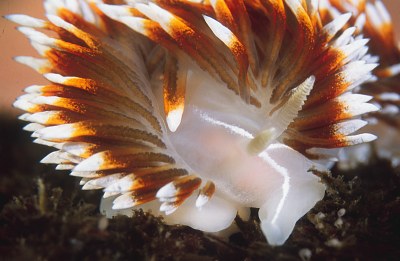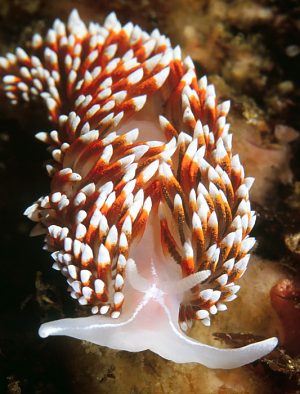

Phidiana lottini
(Lesson, 1831)
Order: NUDIBRANCHIA
Suborder: AEOLIDINA
Family: Glaucidae
DISTRIBUTION
South America - west coast
PHOTO
Antofagasta region, northern Chile. Depth approx 60ft. Photos: Marcelo Krause.
This species has usually been identified as Phidiana inca (d'Orbigny, 1837) but Schroedl (1997) considers P. lottini to be the oldest name for the species. It is a large translucent white species, with opaque white tips to the oral tentacles and the sparsely lamellate rhinophores, with a white V pattern on the head formed from a line running from the tip of each oral tentacle to a patch between the rhinophores. A white medio-dorsal line runs from the rhinophores back down the body. The cerata have a white tip followed by a broad orange band. Below this band the ceratal wall is transparent, the black or dark brown digestive gland showing through the ceratal wall.
References:
• Bergh, L.S.R. (1867) Phidiana lynceus og Ismaila monstrosa. Videnskabelige Meddeleser fra Danske Naturhistorisk Forening, 7-9: 97-130. (Pl.3 A, B; Pl.4 A, B)
• Bergh, L. S. R. (1898). Die Opisthobranchier der Sammlung Plate. Zoologische Jahrbucher, Supplement 4(3): 481-582, pls. 28-33.
• Engel, Hendrik. (1925). Westindische opisthobranchiate Mollusken. Bijdragen tot de kennis der fauna van Curacao. Resultaten eener reis van Dr. C. J. van der Horst in 1920. Bijdragen tot de Dierkunde aflevering, Leiden, 24: 23-35.
• Lesson, R. P. (1831) Voyage autour du monde execute par ordre du roi sur la corvette de sa Majeste, La Coquille, pendant les annees 1822, 1823, 1824, et 1825, Zoologie 2(1): 239-455, pls. 1-16. [Nudibranchia pp. 280-291, pl. 14].
• Marcus, Er. (1959) Reports from the Lund University Chile Expedition 1948-49, No. 36. Lamellariacea und Opisthobranchia. Lunds Universitets Arsskrift (Ny Foljd), Avd. 2, 55(9): 1-133.
• D'Orbigny, A. D. 1835-1846. Voyage dans l'Amerique Meridionale (le Bresil, la republique orientale de l'Uruguay, la Republique argentine, la Patagonie, la republique du Chili, la
republique de Bolivia, la republique de Perou) execute pendant les annees 1826 - 1833, par
Alcide d'Orbigny. 5. Mollusques, pp. 1-48 [1835]; pp. 49-184 [1836]; pp. 185-376 [1837]; pp. 377-408 [1840]; pp. 409-488 [1841]; pp. 489-758 [1846], pls. 1-85 [1846]. Pitois-Levrault, Paris. [Nudibranchia pp. 180-200, pls. 13-17].
• Schroedl, M (1997) Range extensions of Magellanic Nudibranchs (Opisthobranchia) into the Peruvian faunal province. The Veliger, 40(1): 38-42.
Rudman, W.B., 2002 (December 18) Phidiana lottini (Lesson, 1831). [In] Sea Slug Forum. Australian Museum, Sydney. Available from http://www.seaslugforum.net/find/phidlott
Related messages
Re: Phidiana lottini from Chile
December 31, 2002
From: Michael Schroedl
Dear Bill,
Marcelo Krause's photo from Chile is Phidiana lottini.
All the best, and Merry Christmas,
Michael
schroedl@zi.biologie.uni-muenchen.de
Schroedl, M, 2002 (Dec 31) Re: Phidiana lottini from Chile. [Message in] Sea Slug Forum. Australian Museum, Sydney. Available from http://www.seaslugforum.net/find/8764Thanks Michael,
Bill Rudman
Phidiana lottini from Chile
December 30, 2002
From: Marcelo Krause


Bill,
Here are some pictures taken at Antofagasta region, North of Chile. The water temp was 12C and the depth was around 60ft. This species was found in colonies of 10 or more nudis. Once I counted 13 in a 1 metre
radius.
Best regards,
Marcelo.
marcelo@underwater.com.br
Krause, M., 2002 (Dec 30) Phidiana lottini from Chile. [Message in] Sea Slug Forum. Australian Museum, Sydney. Available from http://www.seaslugforum.net/find/8720Dear Marcelo,
From its size, and the fact that it is quite common, I am pretty sure this is Phidiana lottini, a large aeolid which was previously known as Phidiana inca. from your photos, it is quite a spectacular animal. It is interesting to hear of them occurring in aggregations. Perhaps a large colony of their food [a large hydroid perhaps?] was there. I have asked Michael Schroedl to confirm its identity.
Best wishes,
Bill Rudman
